Kostenki 14
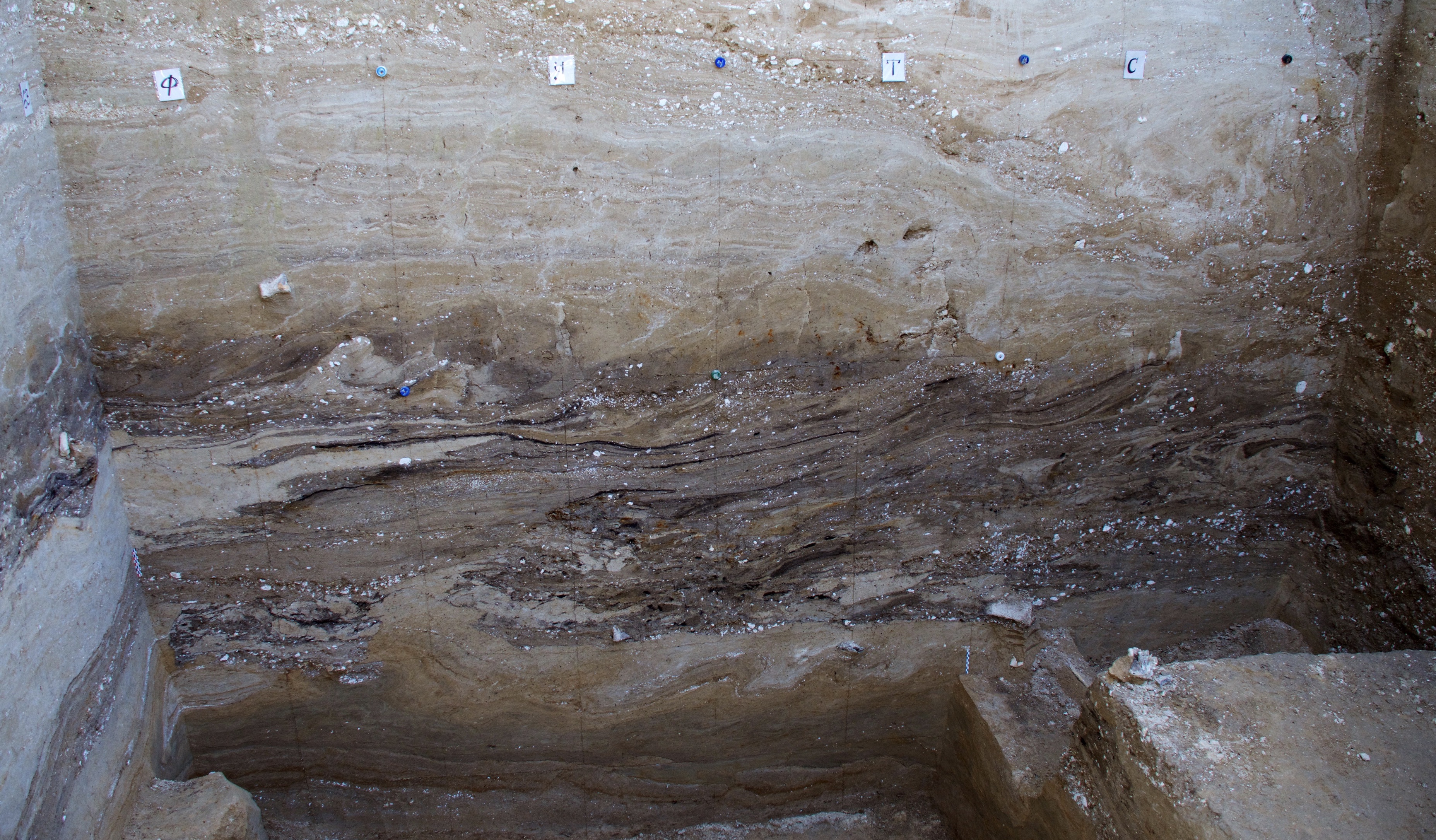
Section of Kostenki 14 during the excavations in 2017.
Kostenki 14 is part of the Kostenki-Borshevo site complex on the Don river, one of the more important Upper Palaeolithic site-complexes of Europe. The deposits at Kostenki 14 have provided rich archaeological assemblages and important palaeoclimatological/-environmental datasets. It is located close to the sites Kostenki 16 and Kostenki 5. Based on previous fieldwork at Kostenki 14, the Early Upper Palaeolithic (EUP) sequence includes at the base the cultural layer IVb that has been dated to 37/36 ka uncal BP and cannot be attributed to any known EUP industry. Above and separated from layer IVb by sterile deposits, two layers with undiagnostic lithic artefacts are known (dated to 34.5 and 33 ka uncal BP), the Layer in the Fossil Soil and the Layer IVa. Above and associated with lenses of volcanic ash the Aurignacian layer (Layer in the ash), including personal ornaments, is reported. Associated charcoals provided ages of 32.4 ka uncal BP.
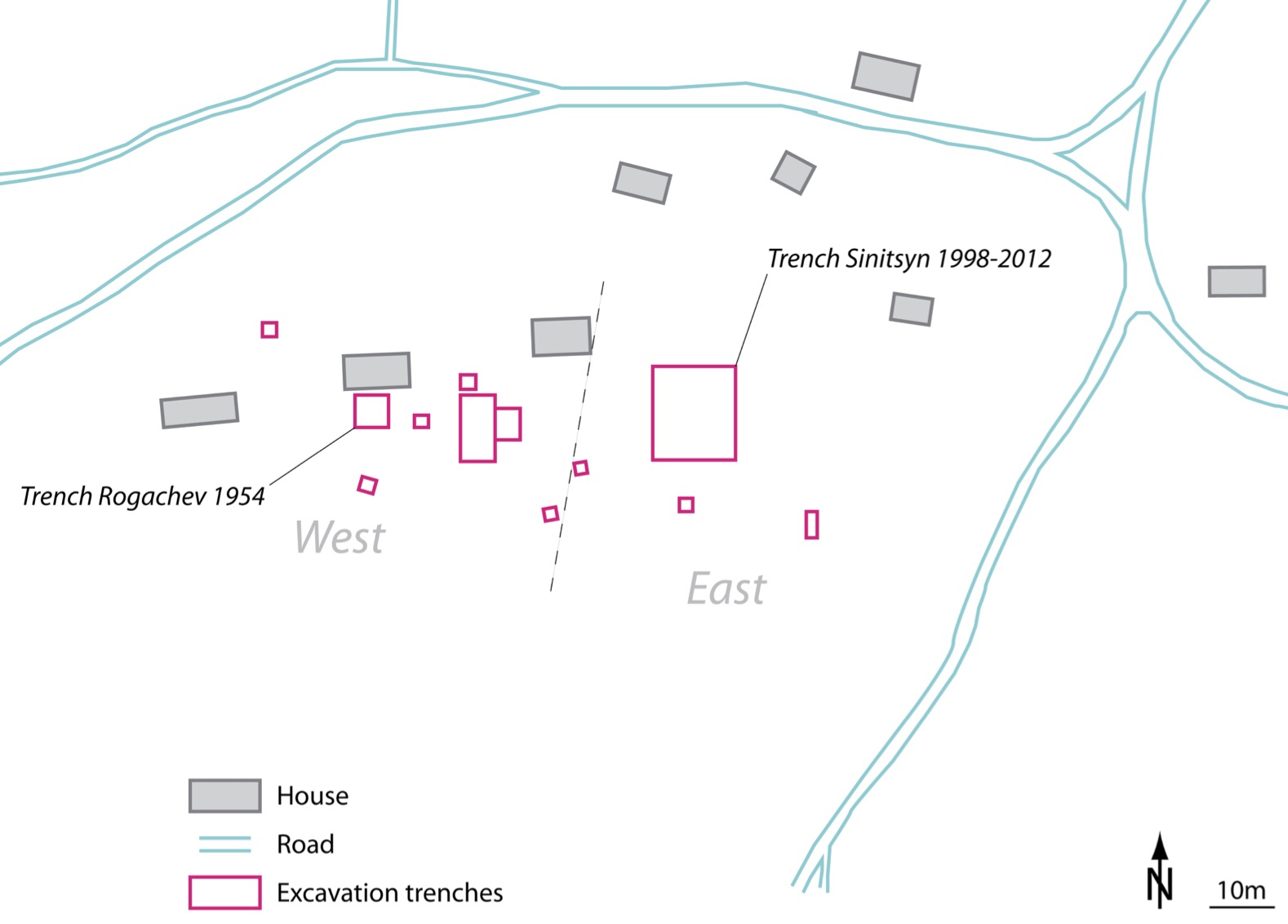
Map of the site Kostenki 14 showing the location of the trenches. NEMO-ADAP's research concentrates on the large eastern trench of A Sinitsyn.
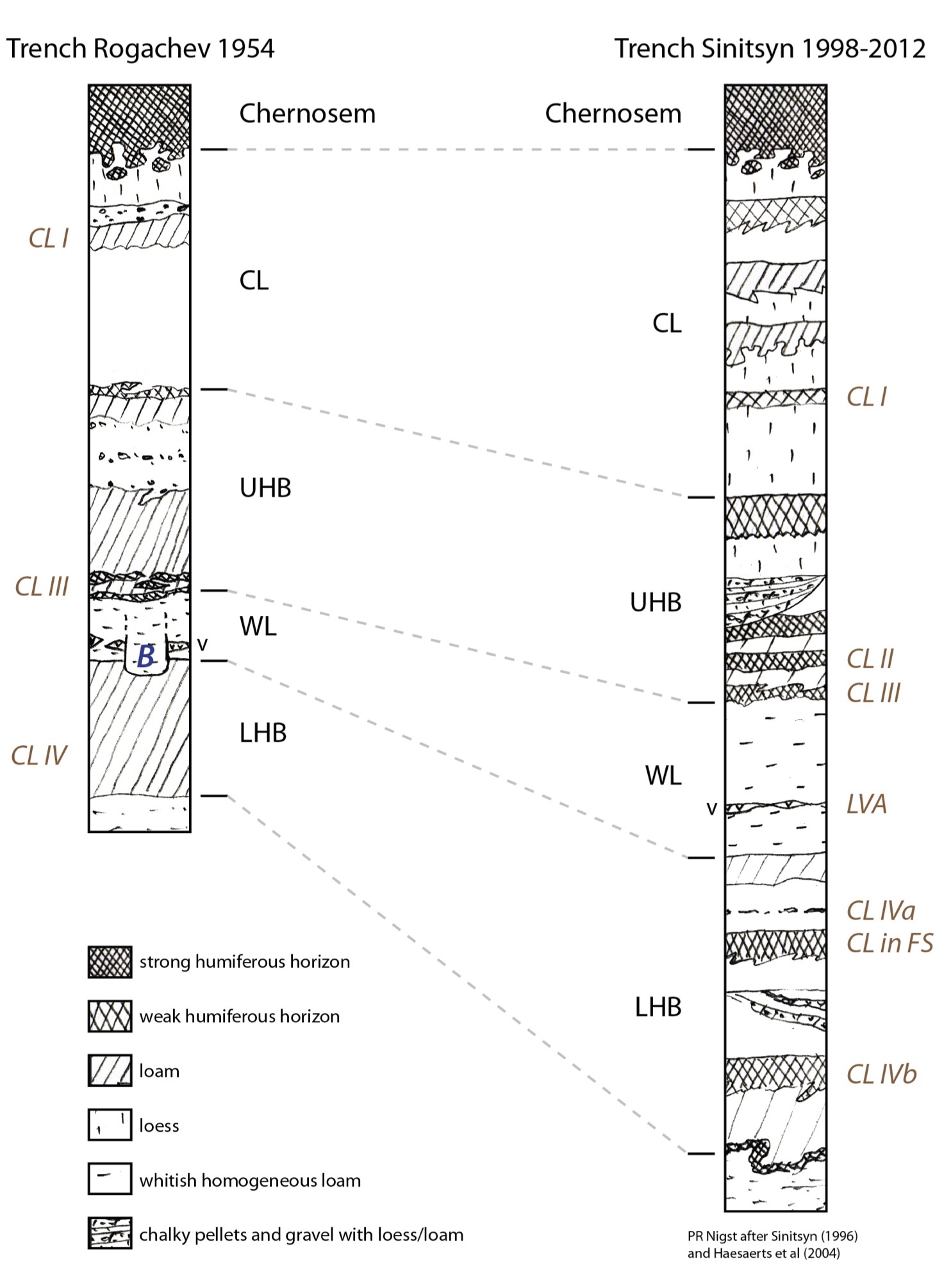
Stratigraphic schema of Kostenki 14, showing Rogachev’s 1954 section, where the human skeleton in the burial (B) was found, and the more recent section excavated by Sinitsyn 1998-2012 on the eastern part of the site. Stratigraphic logs not to scale. Figure compiled after Sinitsyn (1996) and Haesaerts et al. (2004).

Photograph of the section 2012 with labels of stratigraphic units and cultural layers. Abbreviations: CL: Cover Loam, UHB: Upper Humic Bed, WL: Whitish Loam, LHC: Lower Humic Bed, v: volcanic ash. Cultural Layers (CL) are shown in brown and italic font: LVA: Layer in the Volcanic Ash, CL in FS: Cultural Layer in the Fossil Soil.
On of the more interesting aspects of the Kostenki 14 sequence is the fact that the EUP deposits encompass two external stratigraphic markers: (1) a volcanic ash layer (with the Aurignacian assemblage) attributed to the Campanian Ignimbrite (CI) eruption, and (2) the Laschamp palaeomagnetic excursion (LPE). Both markers are of crucial importance for the current discussions of the chronostratigraphic position of the EUP throughout Eurasia. With potential limitations of radiocarbon dates due to unsuccessful removal of contaminants and hence underestimations of the true age of the samples the identification of the CI ash and the LPE offers independent chronostratigraphic marker horizons. Equally important is a detailed description of the deposits and the sedimentary dynamics, one of the key objectives for the current project's work besides radiocarbon dating, in order to understand the formation of the deposits and post depositional alterations.
Kostenki 14 is also known for one of the oldest modern human burials in Europe - providing us with one of the first modern human fossils in Europe. The skeleton was discovered during excavations in the early 20th century.

Kostenki 14, eastern trench: Excavation in the Cultural Layer in the Volcanic Ash.
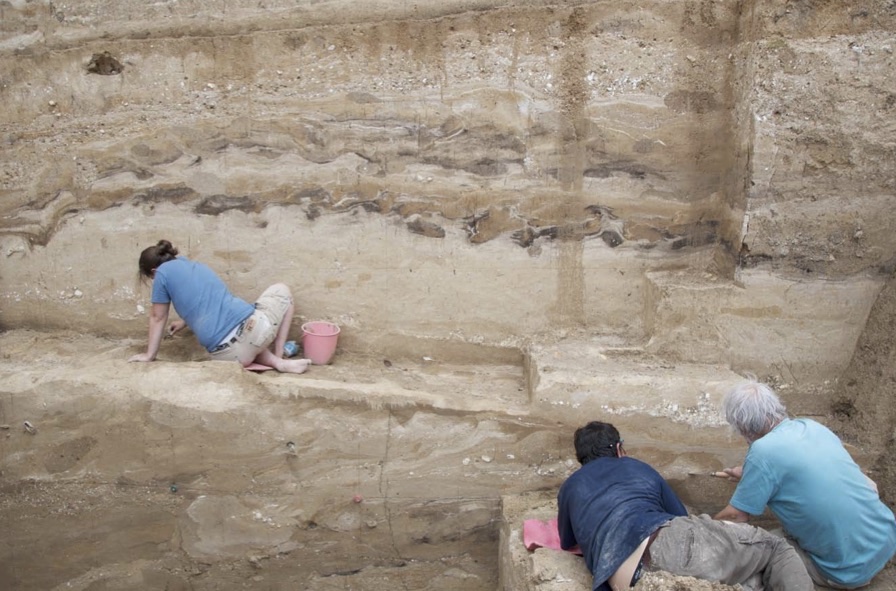
Kostenki 14, eastern trench: Excavation in the Cultural Layer in the Volcanic Ash (left) and stratigraphic analysis of the section of the Lower Humid Bed (right).
Our team has been involved in a number of topics at Kostenki 14:
1) Stratigraphy, Sedimentary Dynamics and Chronostratigraphy:
Our team members Paul Haesaerts and Stéphane Pirson have been analyzing the stratigraphy, sedimentary dynamics and chronostratigraphy of the long sequence at Kostenki 14, eastern trench. Kostenki 14, eastern trench, is excavated by a team around Andrei Sinitsyn since the 1990s.
Our fieldwork includes analysis of sections and sampling for cryptotephra analysis. Analysis of the section includes a detailed section drawing and micro-stratigraphic analysis as well as a study of the sedimentary dynamics to understand the formation of the deposits.
Thanks to Andrei Sinitsyn and his team, we had access to the ash deposits related to the Campagnian Ignimbrite (CI/Y5) eruption about 40,000 years ago and the archaeology within it. Our team’s work focused on the formation of the ash layer, its re-working through various processes. A better understanding of the degree of re-working is essential for the use of CI/Y5 ash deposits at Kostenki 14 as a chronostratigraphic marker horizon. We are also re-assessing the location of the ‘Aurignacian Layer in the ash’, an archaeological horizon located below, within and above the ash in order to contribute to a better resolution its age and chronostratigraphic position.
This project is a collaboration with Andrei Sinitsyn (Institute of the History of Material Culture, Russian Academy of Sciences, St. Petersburg). Further partners are: Paul Haesaerts (Royal Belgian Institute of Natural Sciences), Stephane Prison (Awap), and Freddy Damblon (Royal Belgian Institute of Natural Sciences).
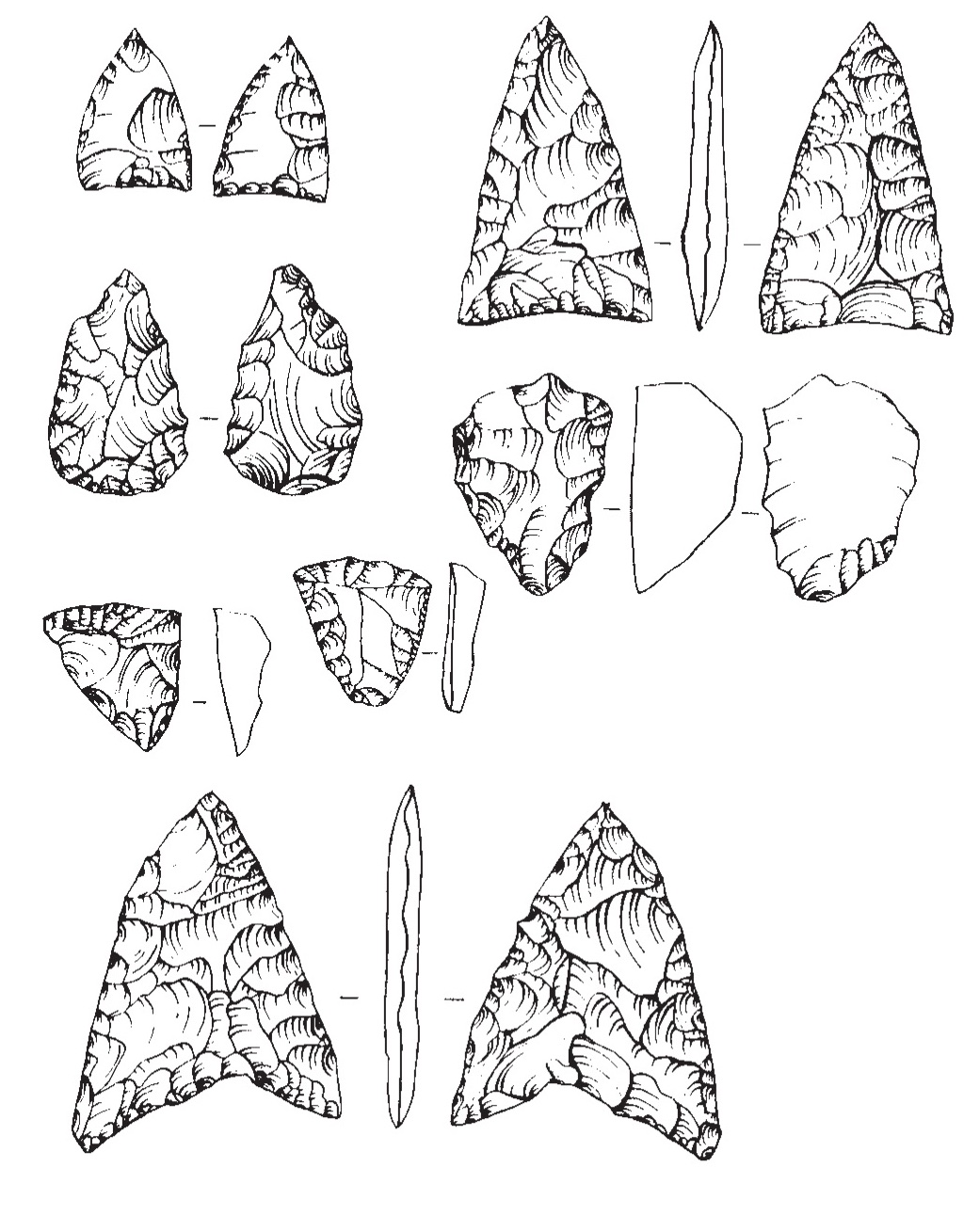
Selection of Streletskian lithic from Kostenki 1 (redrawn after Sinistysn 2003).
2) New chronology for the Early Upper Palaeolithic:
We are collecting and selecting charcoal samples for radiocarbon dating (AMS) the Early Upper Palaeolithic occupation of the Kostenki-Borshevo region. Selected sites include Kostenki 1, 12 and 14. Our results for the Streletskian layers at Kostenki 1 and 12 suggest older ages for these layers than previously thought.
This project is a collaboration with Andrei Sinitsyn (Institute of the History of Material Culture, Russian Academy of Sciences, St. Petersburg). Further partners are: Paul Haesaerts (Royal Belgian Institute of Natural Sciences), Stephane Prison (Awap), and Freddy Damblon (Royal Belgian Institute of Natural Sciences).
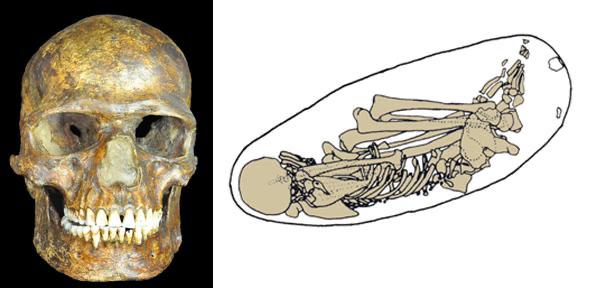
Kostenki 14 burial skull (left) and illustration of the burial (left). Credit: Peter the Great Museum (left) and Philip Nigst (right, redrawn after Klein, 1969).
3) Contribution to the study of the genome of the Kostenki 14 burial and implications for the population history of Upper Pleistocene Europe:
Our team contributed to the analysis of the genome of more than 36,000 year-old skeleton from the site Kostenki 14 (see link to publication below). The skeleton originated from a burial and was excavated in the 1950s. The genome reveals an early divergence of Eurasians once they had left Africa, and allows scientists to better assess the point at which ‘admixture’ - or interbreeding - between Eurasians and Neanderthals occurred. The latest research also points to a previously unknown population lineage as old as the first population separations since humans dispersed out of Africa.
The researchers, led by Eske Willerslev from the Centre for GeoGenetics at the University of Copenhagen, recovered and sequenced the complete genome of a man who was buried about 37,000 years ago at the site of Kostenki 14 (also known as Markina Gora) in western Russia. The study provides unique insights into the history of the continent. The genome shows that once modern humans had dispersed out of Africa and into Eurasia, they separated at least before 37,000-years ago into at least three populations, whose descendants would develop the unique features that reflect the core of the diversity of non-African modern humans.
Since then, despite major climatic fluctuations, one of these groups - Palaeolithic Europeans - persisted as a population, ebbing and flowing by moments of contraction and expansion, but persisting intertwined until the arrival of farmers from the Middle East in the last 8,000 years, with whom they mixed extensively. The Kostenki and other ancient genomes show that for 30,000-years there was a single meta-population in Europe, consisting of Palaeolithic hunter-gatherer groups that split up, mixed, dispersed and changed. Only when farmers from the Near East arrived approximately 8,000 years ago, did the structure of the European population change significantly.
The study also shows that, as with all living Eurasians, the Kostenki 14 man's genome included a small percentage of Neanderthal genes. While this confirms earlier findings, the current study revealed that the Kostenki 14 individual had a slightly higher percentage of Neanderthal genes than ever observed before. Further, the genetic fragments that this individual inherited from a Neanderthal ancestor are larger, i.e. not yet broken by the thousands of recombination events that have occurred since. This allowed the team of scientists to estimate the time of human-Neanderthal admixture to 54,000 years ago.
Original publication in Science:
Seguin-Orlando, A., Korneliussen, T. S., Sikora, M., Malaspinas, A.-S., Manica, A., Moltke, I., Albrechtsen, A., Ko, A., Margaryan, A., Moiseyev, V., Goebel, T., Westaway, M., Lambert, D., Khartanovich, V., Wall, J. D., Nigst, P. R., Foley, R. A., Lahr, M. M., Nielsen, R., . . . Willerslev, E. (2014). Genomic structure in Europeans dating back at least 36,200 years. Science, 346(6213), 1113-1118. https://www.doi.org/10.1126/science.aaa0114
All images © by Philip R. Nigst, unless otherwise stated.
